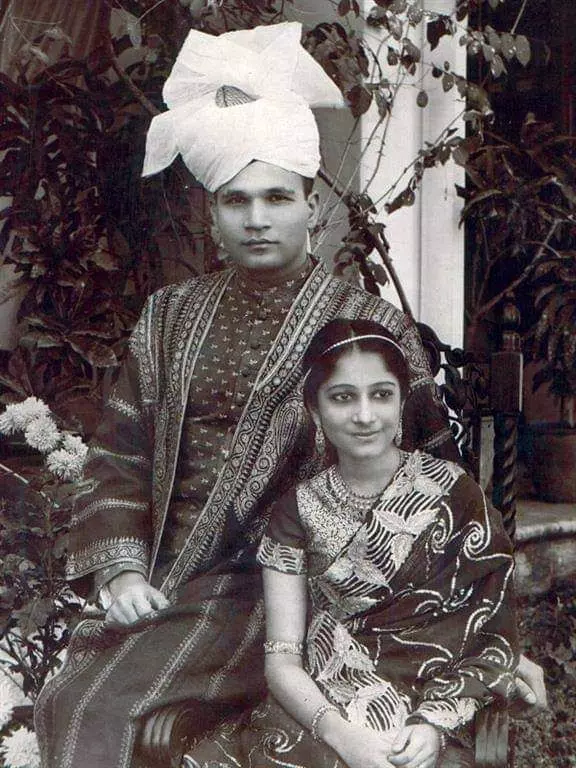Remembering the People Behind the First Republic Day of India

OFFICER RANK: Badruddin Tyabji was a 1936-batch ICS officer of Punjab cadre. His wife, Surayya was a painter(Images credit -thepatriot.in
Every year on January 26th, the Tyabji family gathers in their West End Colony home in Delhi to watch the Republic Day parade. This day holds a special significance for them, as their late patriarch, Badruddin Tyabji, played a pivotal role in organizing the very first Republic Day celebrations in 1950.
Tyabji, a 1936 batch Indian Civil Service officer, was entrusted with overseeing the arrangements for the historic day. He meticulously managed both the President House ceremony and the grand parade at Irwin Stadium (now Major Dhyan Chand National Stadium).
But the story goes beyond just Tyabji. His wife, Surayya Tyabji, a talented painter, played an equally crucial role. Based on the final design adopted by the Constituent Assembly, she created the prototype of the Tricolour on paper. This prototype then served as the basis for the flag that unfurled proudly on that momentous day.
Recalling the hectic days leading up to the event, Tyabji, in a 1994 interview, described the immense responsibility entrusted to him by Prime Minister Jawaharlal Nehru. He shuttled between President House and Irwin Stadium, finalizing every detail with unwavering dedication.
Meanwhile, Rajendra Prasad, soon to be sworn in as India's first President, also had a busy schedule. He paid homage to Mahatma Gandhi at Raj Ghat before proceeding to President House for the swearing-in ceremony.
But before the would-be President of India could get to the President House, C Rajagopalachari, the Governor General of India, had already reached there. The latter used to live in the double-storeyed bungalow at the then 10, Hastings Road, which was later renamed after him as Rajaji Marg. Edwin Lutyens, the chief architect of New Delhi, also lived in the bungalow, and so Pranab Kumar Mukherjee, who also lived in that house after demitting his office of President of India.
“Dr Rajendra Prasad was sworn in as the country’s first President at around 9 am by the Governor General of India, C. Rajagopalachari. Rajvanshi Devi, his wife, and other family members were also there. The swearing-in ceremony was attended by over 500 guests, who had assembled inside the Durbar Hall. President Sukarno of Indonesia and several members of the Diplomatic Corps, members of the Constituent Assembly and prominent citizens had graced the occasion. The President was dressed in black achkan, white churidar and a white Gandhi cap. Pandit Nehru and his other Cabinet colleagues were sworn in soon after Rajendra Prasad,” recalled Tyabji, who was named after his grandfather, the third President of Indian National Congress.
Immediately after returning from Raj Ghat, Rajendra Prasad was sworn in. The Chief Justice of India, Sir Hiralal Kania, read the oath of office in Hindi. President Prasad repeated it sentence by sentence.
“The outgoing Governor General, C. Rajagopalachari; our first Prime Minister, Pandit Jawaharlal Nehru, beaming with pride and joy; the Deputy Prime Minister, Sardar Patel; cabinet ministers, judges of the Supreme Court and the Auditor-General of India, were present in the hall to witness the historic moment of India’s history. Pandit Nehru and his other cabinet colleagues were sworn in soon after.”
The national emblem of Ashoka Pillar with three lions was placed in the Durbar Hall for the first time near the throne where the British Viceroys used to sit.
A smiling statue of Lord Buddha was also placed behind the throne for the first time. Rajendra Prasad, the President, who greeted the large gathering smilingly with folded hands, made a short speech in Hindi and English, stating that it was a memorable day in our annals.
“Let us begin by offering our thanks to the Almighty Power who has enabled us to see this day; to the Father of the Nation who showed us and to the world at large his infallible method of Satyagraha, and led us on along it to freedom and to the numberless men and women, whose suffering and sacrifice have rendered the attainment of independence and establishment of this sovereign democratic Republic possible.”
The birth of the Republic was celebrated by the masses in the Capital through Prabhat Pheries (early morning movement of people singing patriotic songs). Outside the Durbar Hall, there were unforgettable scenes of jubilation. Large crowd of men, women and children had assembled in the forecourt of President House.
People raised slogans of Gandhiji-ki-jai and Vande Mataram.
President Prasad's speech resonated with the spirit of the day, expressing gratitude to those who had made India's freedom possible. He emphasized the importance of moving forward as a sovereign democratic republic, guided by the principles of peace and justice.
The celebrations outside the Durbar Hall were equally jubilant. Crowds filled the forecourt, chanting patriotic slogans and waving the Tricolour. The enthusiasm continued as the President's carriage, drawn by horses, made its way through the five-mile route to Irwin Stadium, lined with cheering onlookers.
At the stadium, a 31-gun salute welcomed the first President of India. Students from various schools presented cultural programs, adding to the festive atmosphere. Notably, the security arrangements were minimal, reflecting the trust and connection between the leaders and the people.
Tyabji, who could not sleep for several days ahead of the big occasion, was there managing the affairs carefully with his colleagues. Following very cold weather days in Delhi, brilliant sunshine greeted the Capital on January 26, 1950.
It was India’s defining moment, the day India truly freed itself from the shackles of colonialism to become a Republic. A truly sovereign state.
The talk of the first Republic Day cannot be complete without discussing the role of Tyabji’s wife, Surayya, in the making of the first Tri-colour.
According to Tyabji, “Once the Constituent Assembly finalised our Tri-colour with Ashok Dharma Chakra inside the flag, I was asked to furnish the model of Tri-colour on both paper and cloth.”
Without wasting any time, Badruddin Tyabji went straight to his Sujan Singh Park residence and asked his wife Surayya to make the Tri-colour on paper. She did not disappoint her husband. Once she made it on paper, Tyabji carried the design to the now defunct SC Tailors at Regal building of Connaught Place and asked them to make the Tri-colour in cloth. The rest, as they say, is history.
After retirement from government service, Tyabji also served as the Vice-Chancellor of Aligarh Muslim University in the 1960s. Tyabji passed away in 1999. His legacy lives on through his family, including his daughter Laila Tyabji, a renowned social worker and crafts activist.Tyabji’s first son, Hindal Ahmad, was an IAS officer. He passed away last year.
The Tyabji family's story is a reminder of the countless individuals who contributed to India's journey towards becoming a republic. Their dedication and sacrifice paved the way for the nation we know today. As we celebrate Republic Day each year, let us remember not just the grand spectacle, but also the quiet heroes who made it all possible.
News Input-https://thepatriot.in/
